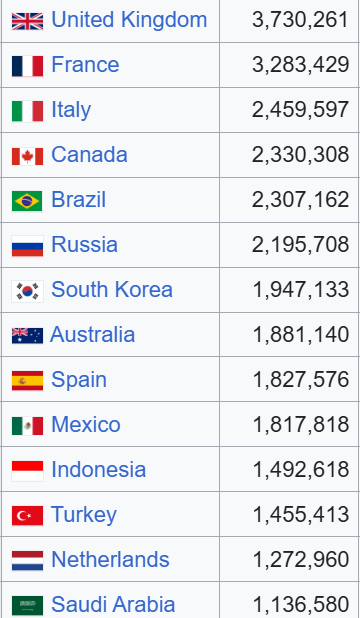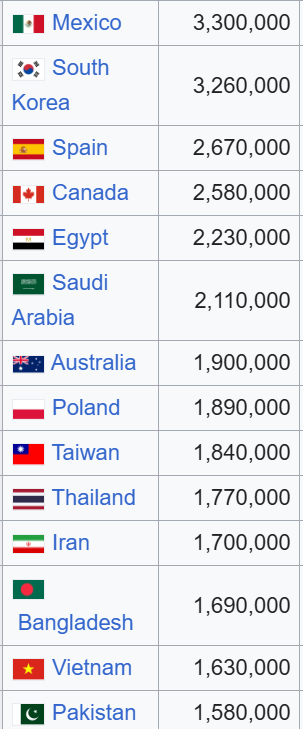Read carefully between the lines, for all this will come to pass.
Let me start by offering an apology to all those whose blood pressure will skyrocket upon reading this thought experiment. As we all know, science–the real thing, not “science”–advances via informed skepticism and experimentation. Some useful experiments can begin as gedanken, thought experiments.
That said, please keep whatever emergency meds you might need handy.
Warlords have a long and mixed history on the world stage. They may be called fiefdoms, but the basic idea is a concentration of power that operates independently of the nominal central authority, which is typically a state government of some kind.
Warlords in the past controlled geographic territories. Today’s warlords control markets and digital territories. The basic idea of warlording is to seize control of a profitable territory or asset with a military-style hierarchy in which power and control are concentrated in the top leadership. This hierarchy is then deployed to defend the warlord / fiefdom’s source of profits and power by any means necessary.
In the past, this defense included making political deals with other warlords and the central authority, and warfare. Today, it means making political deals with other warlords and the central authority, controlling the narrative (some version of obey and grow rich). and establishing a monopoly so the populace has no other option other than to bow down and accept the warlords’ control of their lives.
Warlords have long mastered the art of cutting favorable deals with central authorities, who generally see warlords as potentially troublesome forces that can be co-opted to serve the state. So the Roman Empire made excellent use of the carrot and the stick when it came to co-opting warlords to becoming useful to the empire: we’ll grant you trading rights and local control of your territory, and in exchange you give us your fealty and taxes.
Or we gather the legions and crush you like a bug. A mutually beneficial arrangement was generally reached, and any warlord that did battle and won the first round tended to be brought down by inter-group rivals who saw the risks of taking on the empire and preferred cutting a deal.
Or the empire cut deals with competing warlords who then joined forces to crush the warlord who refused the deal.
In the modern era, does anyone remember Jack Ma? He was the Corporate Warlord who founded Alibaba and secured immeasurable wealth and influence in his digital domain. Alas, the central authority eventually felt threatened by his power and engineered his removal.
Here’s a short list of the Big Tech Corporate Warlords. The market capitalization is a recent estimate, and may vary from today’s valuation, but what’s important here is not precision, it’s the scale of the digital / market domains under the corporate leaders’ control. A trillion here, a trillion there, and pretty soon we’re talking about real power.
Apple: $3.7 trillion
Microsoft: $3.3 trillion
Nvidia: $3 trillion
Amazon: $2.3 trillion
Alphabet (Google): $2.3 trillion
Meta (Facebook): $1.6 trillion
Tesla: $1.3 trillion
Comparing Warlord capitalization to national gross domestic product (GDP) is not an apples to apples comparison, but the point is once again scale: when a corporation’s capex (capital expenditures) exceeds an entire nation’s spending on research, it’s indicative of the scale of power held by Corporate Warlords, warlords whose sole focus is amassing more capital and profits by any means available.
The peasantry is of course disposable, except as cannon fodder should things get serious, and central authorities are obstacles that are best co-opted or bought off.
The trick is to become so useful that the central authorities are forced to accept the threat posed by the warlords’ rising power. Eventually, the warlords control the high ground and the central authority is beseeching the warlords to leave the shell of central authority in place for public consumption.
Here is a list of nominal national GDP on the same scale of Big Tech corporations. The GDP is in thousands, so the nominal UK GDP is $3.7 trillion, about the same as the market cap of Apple.

Here is a list of national GDP adjusted to purchasing power parity, which is considered a more accurate reflection of economic activity and value. The GDP is in thousands, so the PPP GDP of Mexico is $3.3 trillion, about the same as the market cap of Microsoft.

Occasionally warlords took control of the central authority, and discovered ruling a regime is not as easy as running a military-type hierarchy. The problem with ruling a sprawling regime is there are always pesky competing interests who cannot be eliminated as is so easily accomplished within a military-type hierarchy. There are pesky nobles, pesky merchants, pesky religious authorities, a restive class of bourgeois aspirants, peasantry poised to revolt, the uppity Mandarins and the apparatchik class of bureaucrats who may appear to serve the warlords but who secretly despise them.
Warlords soon find that the skills that brought them to power in a corporate structure are ill-adapted to herding the competing interests of a regime. The “market” of power responds to different signals than the commercial market, and warlords–traditional or corporate–keep trying to crush competing nodes of power like they did in the commercial marketplace.
Unlike a marketplace that lends itself to monopoly, the “market” of power fears monopoly above all else. A previously odious competitor soon becomes a valued ally in the task at hand, which is undermining and taking down any warlord seeking to consolidate central power at the expense of all the other nodes of power.
Read carefully between the lines, for all this will come to pass.
My recent books:
Disclosure: As an Amazon Associate I earn from qualifying purchases originated via links to Amazon products on this site.
The Mythology of Progress, Anti-Progress and a Mythology for the 21st Century
print $18,
(Kindle $8.95,
Hardcover $24 (215 pages, 2024)
Read the Introduction and first chapter for free (PDF)
Self-Reliance in the 21st Century print $18,
(Kindle $8.95,
audiobook $13.08 (96 pages, 2022)
Read the first chapter for free (PDF)
The Asian Heroine Who Seduced Me
(Novel) print $10.95,
Kindle $6.95
Read an excerpt for free (PDF)
When You Can’t Go On: Burnout, Reckoning and Renewal
$18 print, $8.95 Kindle ebook;
audiobook
Read the first section for free (PDF)
Global Crisis, National Renewal: A (Revolutionary) Grand Strategy for the United States
(Kindle $9.95, print $24, audiobook)
Read Chapter One for free (PDF).
A Hacker’s Teleology: Sharing the Wealth of Our Shrinking Planet
(Kindle $8.95, print $20,
audiobook $17.46)
Read the first section for free (PDF).
Will You Be Richer or Poorer?: Profit, Power, and AI in a Traumatized World
(Kindle $5, print $10, audiobook)
Read the first section for free (PDF).
The Adventures of the Consulting Philosopher: The Disappearance of Drake (Novel)
$4.95 Kindle, $10.95 print);
read the first chapters
for free (PDF)
Money and Work Unchained $6.95 Kindle, $15 print)
Read the first section for free
Become
a $3/month patron of my work via patreon.com.
Subscribe to my Substack for free
NOTE: Contributions/subscriptions are acknowledged in the order received. Your name and email
remain confidential and will not be given to any other individual, company or agency.
| Thank you, Bert F. ($70), for your wondrously generous subscription to this site — I am greatly honored by your support and readership. |
Thank you, Charlie ($7/month), for your superbly generous subscription to this site — I am greatly honored by your support and readership. |
| Thank you, Ira ($70), for your magnificently generous subscription to this site — I am greatly honored by your support and readership. |
Thank you, Kelly ($5/month), for your splendidly generous subscription to this site — I am greatly honored by your support and readership. |
